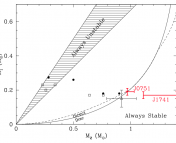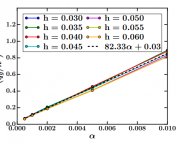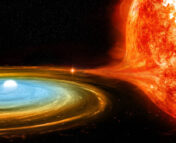
David Trevascus is a graduated honours student in astrophysics from Monash University in Melbourne (applying for PhD positions). In their honours year, they researched planetary systems around white dwarfs, performing hydrodynamic simulations of eccentric gas discs. They currently work as a research assistant processing x-ray image data, and enjoy playing new board games and running a homebrew Dungeons and Dragons campaign during their spare time.
Title: A white dwarf accreting planetary material determined from X-ray observations
Authors: Tim Cunningham, Peter J. Wheatley, Pier-Emmanuel Tremblay, Boris T. Gänsicke, George W. King, Odette Toloza, and Dimitri Veas
First Author’s Institution: Department of Physics, The University of Warwick, Coventry, CV4 7AL, UK
Status: Published in Nature (closed access); Available on Arxiv
A white dwarf is the final stage of life for a low mass star like our Sun. After our Sun burns away all the hydrogen and helium in its core, it leaves behind an inert ball of carbon and oxygen. We have observed thousands of white dwarfs through surveys of the night sky, but we know much less about what happens to the planets around these dead stars. Is there a chance that we might one day be able to see the remnants of an Earth-like planet orbiting a white dwarf?
A phenomenon known as “metal pollution” hints at the existence of planets around white dwarf stars. White dwarfs are covered in a thin outer layer of leftover hydrogen and helium known as the photosphere. Any heavier elements (metals) present in the photosphere will relatively quickly sink out of this layer due to the strong gravitational forces of the white dwarf. Therefore it is surprising that, when we observe the chemical spectra of white dwarfs, we find that 25-50% of them have metals polluting their outer layers. The generally accepted explanation for this pollution is the accretion of planets (and other, smaller bodies) onto the surfaces of these white dwarfs. Today’s paper describes the first known detection of X-ray emissions caused by this type of accretion from the white dwarf G29-38.
Why X-rays?
Why would accreting material emit x-rays? Well, it’s all about what happens when the orbiting material hits the white dwarf. In the process of accreting onto the white dwarf, the orbiting material loses a lot of kinetic energy very quickly. It does this by heating up to high temperatures and producing high energy radiation (i.e. x-rays) that carries away the energy.
We’ve detected x-ray emissions from accreting white dwarfs before, but previous detections have all been from binary star systems, where the accreting material used to belong to the other star. The key differences for this detection were that the photons were concentrated at lower energies and that the overall x-ray luminosity of the event was lower. This stems from the lower mass, and therefore lower accretion rates, of planetary material as opposed to stellar material.
Calculating the Accretion Rate
In order to determine the accretion rate of material onto the white dwarf, we first need to know the x-ray luminosity of the accretion event. This requires us to take the total sum (i.e. the integral) of x-ray flux over different photon energies.
The x-ray flux from this event was measured by the ACIS-S detector on the Chandra X-ray Observatory. This detector is most sensitive to photon energies in the 1.0 – 6.5 keV range. A significant portion of the electrons detected were at lower energies (less than 0.5 keV) where the detector is less sensitive.
The authors of this paper tackled this problem by simulating the x-ray flux created by this accretion event. Their model takes into account the effective temperature of the white dwarf’s photosphere, as well as the composition and temperature distribution of the accreting material. By fitting these models to the observed photon energy distribution the authors were able to determine the total x-ray flux and therefore the luminosity of the emission event.
From the x-ray luminosity, the authors of this paper were able to determine the accretion rate of planetary material onto the white dwarf (since the two are directly proportional). They measured an accretion rate of 1.63×109 grams per second. This is the first direct measurement of the accretion rate of planetary material onto a white dwarf from x-ray observations.
Accretion Rate Comparison
Previous measurements of the accretion rates of planetary material onto a white dwarf have been dependent on what is known as a “steady-state” model. This model assumes the abundances of metals in the photosphere remain roughly constant overtime, as they accrete onto the white dwarf and then diffuse into its core.
The authors of this paper have taken this opportunity to compare their new independent measurement of the accretion rate to steady-state measurements. They find that the measured steady-state accretion rates are approximately an order of magnitude lower than their observations. However, they note that the steady-state accretion rates don’t account for additional mixing of stellar material between layers of the white dwarf found in 3D convection models (as opposed to 1D models) – a phenomenon known as convective overshoot. Accounting for convective overshoot results in a rough match between the two accretion rate measurements.

Answering Questions About Metal Pollution
This method of measuring the instantaneous accretion rate of planetary material onto polluted white dwarfs should help us answer a number of open questions about how white dwarf metal pollution occurs. We know from infrared observations that many polluted white dwarfs also host a dusty debris disc of planetary material (similar to the asteroid or Kuiper belts in our own solar system). We do not yet fully understand the mechanism through which this material is deposited onto the white dwarf’s surface. Neither do we understand the variability that we see in the infrared radiation emitted from these discs over time.
Due to the uncertainties in estimating x-ray flux at lower wavelengths, the authors of this paper do admit that their measurement of the accretion rate is a lower limit for the true accretion rate of planetary material. However, the authors note that future x-ray telescopes, such as the Advanced Telescope for High-ENergy Astrophysics (ATHENA) will be able to better study x-ray emissions from white dwarf planetary systems.
Astrobite edited by Sumeet Kulkarni
Featured image credit: NOIRLab/NSF/AURA/J. da Silva




